Simply Applicable Method for Microplastics Determination in Environmental Samples
Abstract
1. Introduction
2. Results and Discussion
2.1. Identification of MPs Coarse Fraction (1–5 mm)
2.1.1. Polyethylene Terephthalate
2.1.2. Polystyrene
2.1.3. Polyvinyl Chloride
2.1.4. Polypropylene
2.1.5. Polyethylene
2.2. Method Applicability in Environmental Samples
2.2.1. Identification of MPs in the Polymer Blend and Fine Fraction (1 mm–100 μm)
2.2.2. Spiked Environmental Matrices
3. Materials and Methods
3.1. Microplastic Samples: Type, Shape, and Dimension
3.2. Experimental Design for Head Space Microextraction of Volatile Organic Compounds Produced from Melted MPs
3.3. Gas Chromatography and Mass Spectroscopy Analysis
3.4. Standard Reference Materials
3.5. Applicability of Method to Environmental Samples
4. Conclusions
Supplementary Materials
Author Contributions
Funding
Institutional Review Board Statement
Informed Consent Statement
Data Availability Statement
Acknowledgments
Conflicts of Interest
Sample Availability
References
- Horton, A.A.; Walton, A.; Spurgeon, D.J.; Lahive, E.; Svendsen, C. Microplastics in Freshwater and Terrestrial Environments: Evaluating the Current Understanding to Identify the Knowledge Gaps and Future Research Priorities. Sci. Total Environ. 2017, 586, 127–141. [Google Scholar] [CrossRef]
- Nizzetto, L.; Futter, M.; Langaas, S. Are Agricultural Soils Dumps for Microplastics of Urban Origin? Environ. Sci. Technol. 2016, 50, 10777–10779. [Google Scholar] [CrossRef] [PubMed]
- Wang, J.; Liu, X.; Li, Y.; Powell, T.; Wang, X.; Wang, G.; Zhang, P. Microplastics as Contaminants in the Soil Environment: A Mini-Review. Sci. Total Environ. 2019, 691, 848–857. [Google Scholar] [CrossRef]
- Geyer, R.; Jambeck, J.R.; Law, K.L. Production, Use, and Fate of All Plastics Ever Made. Sci. Adv. 2017, 3, e1700782. [Google Scholar] [CrossRef]
- Chae, Y.; An, Y.-J. Current Research Trends on Plastic Pollution and Ecological Impacts on the Soil Ecosystem: A Review. Environ. Pollut. 2018, 240, 387–395. [Google Scholar] [CrossRef]
- Kumar, M.; Xiong, X.; He, M.; Tsang, D.C.W.; Gupta, J.; Khan, E.; Harrad, S.; Hou, D.; Ok, Y.S.; Bolan, N.S. Microplastics as Pollutants in Agricultural Soils. Environ. Pollut. 2020, 265, 114980. [Google Scholar] [CrossRef]
- Dümichen, E.; Eisentraut, P.; Celina, M.; Braun, U. Automated Thermal Extraction-Desorption Gas Chromatography Mass Spectrometry: A Multifunctional Tool for Comprehensive Characterization of Polymers and Their Degradation Products. J. Chromatogr. A 2019, 1592, 133–142. [Google Scholar] [CrossRef] [PubMed]
- Dümichen, E.; Eisentraut, P.; Bannick, C.G.; Barthel, A.K.; Senz, R.; Braun, U. Fast Identification of Microplastics in Complex Environmental Samples by a Thermal Degradation Method. Chemosphere 2017, 174, 572–584. [Google Scholar] [CrossRef] [PubMed]
- Harata, K.; Kitagawa, S.; Iiguni, Y.; Ohtani, H. Identification of Polymer Species in a Complex Mixture by Pyrolysis-Gas Chromatography-Atmospheric Pressure Chemical Ionization-High Resolution Time-of-Flight Mass Spectrometry as a Basis for Environmental Microplastic Analysis. J. Anal. Appl. Pyrolysis 2020, 148, 104828. [Google Scholar] [CrossRef]
- Krauskopf, L.-M.; Hemmerich, H.; Dsikowitzky, L.; Schwarzbauer, J. Critical Aspects on Off-Line Pyrolysis-Based Quantification of Microplastic in Environmental Samples. J. Anal. Appl. Pyrolysis 2020, 104830. [Google Scholar] [CrossRef]
- Peñalver, R.; Arroyo-Manzanares, N.; López-García, I.; Hernández-Córdoba, M. An Overview of Microplastics Characterization by Thermal Analysis. Chemosphere 2020, 242, 125170. [Google Scholar] [CrossRef]
- Sovová, K.; Ferus, M.; Matulková, I.; Španěl, P.; Dryahina, K.; Dvořák, O.; Civiš, S. A Study of Thermal Decomposition and Combustion Products of Disposable Polyethylene Terephthalate (PET) Plastic Using High Resolution Fourier Transform Infrared Spectroscopy, Selected Ion Flow Tube Mass Spectrometry and Gas Chromatography Mass Spectrometry. Mol. Phys. 2008, 106, 1205–1214. [Google Scholar] [CrossRef]
- Steinmetz, Z.; Kintzi, A.; Muñoz, K.; Schaumann, G.E. A Simple Method for the Selective Quantification of Polyethylene, Polypropylene, and Polystyrene Plastic Debris in Soil by Pyrolysis-Gas Chromatography/Mass Spectrometry. J. Anal. Appl. Pyrolysis 2020, 147, 104803. [Google Scholar] [CrossRef]
- Beyler, C.L.; Hirschler, M.M. Thermal Decomposition of Polymers. SFPE Handb. Fire Prot. Eng. 2002, 2, 22. [Google Scholar]
- Holland, B.J.; Hay, J.N. The Thermal Degradation of PET and Analogous Polyesters Measured by Thermal Analysis–Fourier Transform Infrared Spectroscopy. Polymer 2002, 43, 1835–1847. [Google Scholar] [CrossRef]
- PlasticAtlas. Plastic Atlas 2019: Facts and Figures about the World of Synthetic Polymers; Heinrich Böll Foundation: Berlin, Germany, 2019; ISBN 978-3-86928-211-4. [Google Scholar]
- Faravelli, T.; Pinciroli, M.; Pisano, F.; Bozzano, G.; Dente, M.; Ranzi, E. Thermal Degradation of Polystyrene. J. Anal. Appl. Pyrolysis 2001, 103–121. [Google Scholar] [CrossRef]
- Sullivan, G.L.; Gallardo, J.D.; Jones, E.W.; Hollliman, P.J.; Watson, T.M.; Sarp, S. Detection of Trace Sub-Micron (Nano) Plastics in Water Samples Using Pyrolysis-Gas Chromatography Time of Flight Mass Spectrometry (PY-GCToF). Chemosphere 2020, 249, 126179. [Google Scholar] [CrossRef]
- Fischer, M.; Scholz-Böttcher, B.M. Simultaneous Trace Identification and Quantification of Common Types of Microplastics in Environmental Samples by Pyrolysis-Gas Chromatography–Mass Spectrometry. Environ. Sci. Technol. 2017, 51, 5052–5060. [Google Scholar] [CrossRef]
- Matsui, K.; Ishimura, T.; Mattonai, M.; Iwai, I.; Watanabe, A.; Teramae, N.; Ohtani, H.; Watanabe, C. Identification Algorithm for Polymer Mixtures Based on Py-GC/MS and Its Application for Microplastic Analysis in Environmental Samples. J. Anal. Appl. Pyrolysis 2020, 149, 104834. [Google Scholar] [CrossRef]
- Nisar, J.; Khan, M.S.; Iqbal, M.; Shah, A.; Ali, G.; Sayed, M.; Khan, R.A.; Shah, F.; Mahmood, T. Thermal Decomposition Study of Polyvinyl Chloride in the Presence of Commercially Available Oxides Catalysts. Adv. Polym. Technol. 2018, 37, 2336–2343. [Google Scholar] [CrossRef]
- McNeill, I.C.; Memetea, L.; Cole, W.J. A Study of the Products of PVC Thermal Degradation. Polym. Degrad. Stab. 1995, 49, 181–191. [Google Scholar] [CrossRef]
- Marcilla, A.; Beltrán, M. Kinetic Models for the Thermal Decomposition of Commercial PVC Resins and Plasticizers Studied by Thermogravimetric Analysis. Polym. Degrad. Stab. 1996, 53, 251–260. [Google Scholar] [CrossRef]
- Taghi Zadeh, M.T.; Dastar Lighvan, H. The Study of the Thermal Stability of Poly(Vinyl-Chloride) with Different Molecular Weight. J. Sci. (Univ. Tehran) 2007, 33, 25–32. [Google Scholar]
- Wypych, J. Polyvinyl Chloride Degradation; University of Ife: Ile-Ife, Nigeria, 1985. [Google Scholar]
- Panseri, S.; Chiesa, L.M.; Zecconi, A.; Soncini, G.; De Noni, I. Determination of Volatile Organic Compounds (VOCs) from Wrapping Films and Wrapped PDO Italian Cheeses by Using HS-SPME and GC/MS. Molecules 2014, 19, 8707–8724. [Google Scholar] [CrossRef]
- Yamashita, K.; Yamamoto, N.; Mizukoshi, A.; Noguchi, M.; Ni, Y.; Yanagisawa, Y. Compositions of Volatile Organic Compounds Emitted from Melted Virgin and Waste Plastic Pellets. J. Air Waste Manag. Assoc. 2009, 59, 273–278. [Google Scholar] [CrossRef] [PubMed]
- Soják, L.; Kubinec, R.; Jurdáková, H.; Hájeková, E.; Bajus, M. High Resolution Gas Chromatographic–Mass Spectrometric Analysis of Polyethylene and Polypropylene Thermal Cracking Products. J. Anal. Appl. Pyrolysis 2007, 78, 387–399. [Google Scholar] [CrossRef]
- Bockhorn, H.; Hornung, A.; Hornung, U.; Schawaller, D. Kinetic Study on the Thermal Degradation of Polypropylene and Polyethylene. J. Anal. Appl. Pyrolysis 1999, 48, 93–109. [Google Scholar] [CrossRef]
- Marin, N.; Collura, S.; Sharypov, V.I.; Beregovtsova, N.G.; Baryshnikov, S.V.; Kutnetzov, B.N.; Cebolla, V.; Weber, J.V. Copyrolysis of Wood Biomass and Synthetic Polymers Mixtures. Part II: Characterisation of the Liquid Phases. J. Anal. Appl. Pyrolysis 2002, 65, 41–55. [Google Scholar] [CrossRef]
- Dümichen, E.; Barthel, A.-K.; Braun, U.; Bannick, C.G.; Brand, K.; Jekel, M.; Senz, R. Analysis of Polyethylene Microplastics in Environmental Samples, Using a Thermal Decomposition Method. Water Res. 2015, 85, 451–457. [Google Scholar] [CrossRef] [PubMed]
- ASTM International. D8333-20 Standard Practice for Preparation of Water Samples with High, Medium, or Low Suspended Solids for Identification and Quantification of Microplastic Particles and Fibers Using Raman Spectroscopy, IR Spectroscopy, or Pyrolysis-GC/MS; ASTM International: West Conshohocken, PA, USA, 2020. [Google Scholar]
- ASTM International WK67788 New Test Method for Identification of Microplastic Particles and Fibers in All Matrices of High and Low Turbidity Water Samples Including Municipal Raw Wastewater Using Pyrolysis-GC/MS. Available online: https://www.astm.org/DATABASE.CART/WORKITEMS/WK67788.htm (accessed on 23 December 2020).
- ASTM International WK67565 New Test Method for Spectroscopic Identification and Quantification of Microplastic Particles and Fibers in All High and Low Turbidity Water Matrices Including Municipal Wastewater Using IR and Raman Spectroscopy. Available online: https://www.astm.org/DATABASE.CART/WORKITEMS/WK67565.htm (accessed on 23 December 2020).
- Horodytska, O.; Cabanes, A.; Fullana, A. Non-Intentionally Added Substances (NIAS) in Recycled Plastics. Chemosphere 2020, 251, 126373. [Google Scholar] [CrossRef] [PubMed]
- Polymer Properties Database. Available online: http://polymerdatabase.com/polymer%20chemistry/pc%20index.html (accessed on 13 March 2021).
- Kusch, P. The Application of Headspace: Solid-Phase Microextraction (HS-SPME) Coupled with Gas Chromatography/Mass spectrometry (GC/MS) for the Characterization of Polymers. In Gass Chromatography: Analysis, Methods and Practices; Warren, V., Ed.; Biochemistry research trends; Nova Science Publishers: New York, NY, USA, 2017; pp. 69–103. ISBN 978-1-5361-1990-9. [Google Scholar]
- Kusch, P.; Knupp, G. Headspace-SPME-GC-MS Identification of Volatile Organic Compounds Released from Expanded Polystyrene. J. Polym. Environ. 2004, 12, 83–87. [Google Scholar] [CrossRef]
- La Nasa, J.; Biale, G.; Fabbri, D.; Modugno, F. A Review on Challenges and Developments of Analytical Pyrolysis and Other Thermoanalytical Techniques for the Quali-Quantitative Determination of Microplastics. J. Anal. Appl. Pyrolysis 2020, 149, 104841. [Google Scholar] [CrossRef]
- Saido, K.; Taguchi, H.; Yada, S.; Ishihara, Y.; Kuroki, T.; Ryu, I.-J.; Chung, S.-Y. Thermal Decomposition Products of Phthalates with Poly(Vinyl Chloride) and Their Mutagenicity. Macromol. Res. 2003, 11, 178–182. [Google Scholar] [CrossRef]
- Tawfik, S.Y.; Asaad, J.N.; Sabaa, M.W. Thermal and Mechanical Behaviour of Flexible Poly(Vinyl Chloride) Mixed with Some Saturated Polyesters. Polym. Degrad. Stab. 2006, 91, 385–392. [Google Scholar] [CrossRef]
- Gijsman, P.; Hennekens, J.; Vincent, J. The Mechanism of the Low-Temperature Oxidation of Polypropylene. Polym. Degrad. Stab. 1993, 42, 95–105. [Google Scholar] [CrossRef]
- Zarfl, C. Promising Techniques and Open Challenges for Microplastic Identification and Quantification in Environmental Matrices. Anal. Bioanal. Chem. 2019, 411, 3743–3756. [Google Scholar] [CrossRef]
- Schwaferts, C.; Niessner, R.; Elsner, M.; Ivleva, N.P. Methods for the Analysis of Submicrometer- and Nanoplastic Particles in the Environment. TrAC Trends Anal. Chem. 2019, 112, 52–65. [Google Scholar] [CrossRef]
- Stock, F.; Kochleus, C.; Bänsch-Baltruschat, B.; Brennholt, N.; Reifferscheid, G. Sampling Techniques and Preparation Methods for Microplastic Analyses in the Aquatic Environment—A Review. TrAC Trends Anal. Chem. 2019, 113, 84–92. [Google Scholar] [CrossRef]
- Nuelle, M.-T.; Dekiff, J.H.; Remy, D.; Fries, E. A New Analytical Approach for Monitoring Microplastics in Marine Sediments. Environ. Pollut. 2014, 184, 161–169. [Google Scholar] [CrossRef]
- Singh, A.A.; Afrin, S.; Karim, Z. Green Composites: Versatile Material for Future. In Green Biocomposites; Jawaid, M., Salit, M.S., Alothman, O.Y., Eds.; Green Energy and Technology; Springer International Publishing: Cham, Germany, 2017; pp. 29–44. ISBN 978-3-319-49381-7. [Google Scholar]
- Hartmann, N.B.; Hüffer, T.; Thompson, R.C.; Hassellöv, M.; Verschoor, A.; Daugaard, A.E.; Rist, S.; Karlsson, T.; Brennholt, N.; Cole, M.; et al. Are We Speaking the Same Language? Recommendations for a Definition and Categorization Framework for Plastic Debris. Environ. Sci. Technol. 2019, 53, 1039–1047. [Google Scholar] [CrossRef]
- Demets, R.; Roosen, M.; Vandermeersch, L.; Ragaert, K.; Walgraeve, C.; De Meester, S. Development and Application of an Analytical Method to Quantify Odour Removal in Plastic Waste Recycling Processes. Resour. Conserv. Recycl. 2020, 161, 104907. [Google Scholar] [CrossRef]
- Dutra, C.; Pezo, D.; de Alvarenga Freire, M.T.; Nerín, C.; Reyes, F.G.R. Determination of Volatile Organic Compounds in Recycled Polyethylene Terephthalate and High-Density Polyethylene by Headspace Solid Phase Microextraction Gas Chromatography Mass Spectrometry to Evaluate the Efficiency of Recycling Processes. J. Chromatogr. A 2011, 1218, 1319–1330. [Google Scholar] [CrossRef]
- Curran, K.; Underhill, M.; Gibson, L.T.; Strlic, M. The Development of a SPME-GC/MS Method for the Analysis of VOC Emissions from Historic Plastic and Rubber Materials. Microchem. J. 2016, 124, 909–918. [Google Scholar] [CrossRef]
- Gröning, M.; Hakkarainen, M. Headspace Solid-Phase Microextraction with Gas Chromatography/Mass Spectrometry Reveals a Correlation between the Degradation Product Pattern and Changes in the Mechanical Properties during the Thermooxidation of in-Plant Recycled Polyamide 6,6. J. Appl. Polym. Sci. 2002, 86, 3396–3407. [Google Scholar] [CrossRef]
- Šunta, U.; Prosenc, F.; Trebše, P.; Bulc, T.G.; Kralj, M.B. Adsorption of Acetamiprid, Chlorantraniliprole and Flubendiamide on Different Type of Microplastics Present in Alluvial Soil. Chemosphere 2020, 261, 127762. [Google Scholar] [CrossRef]
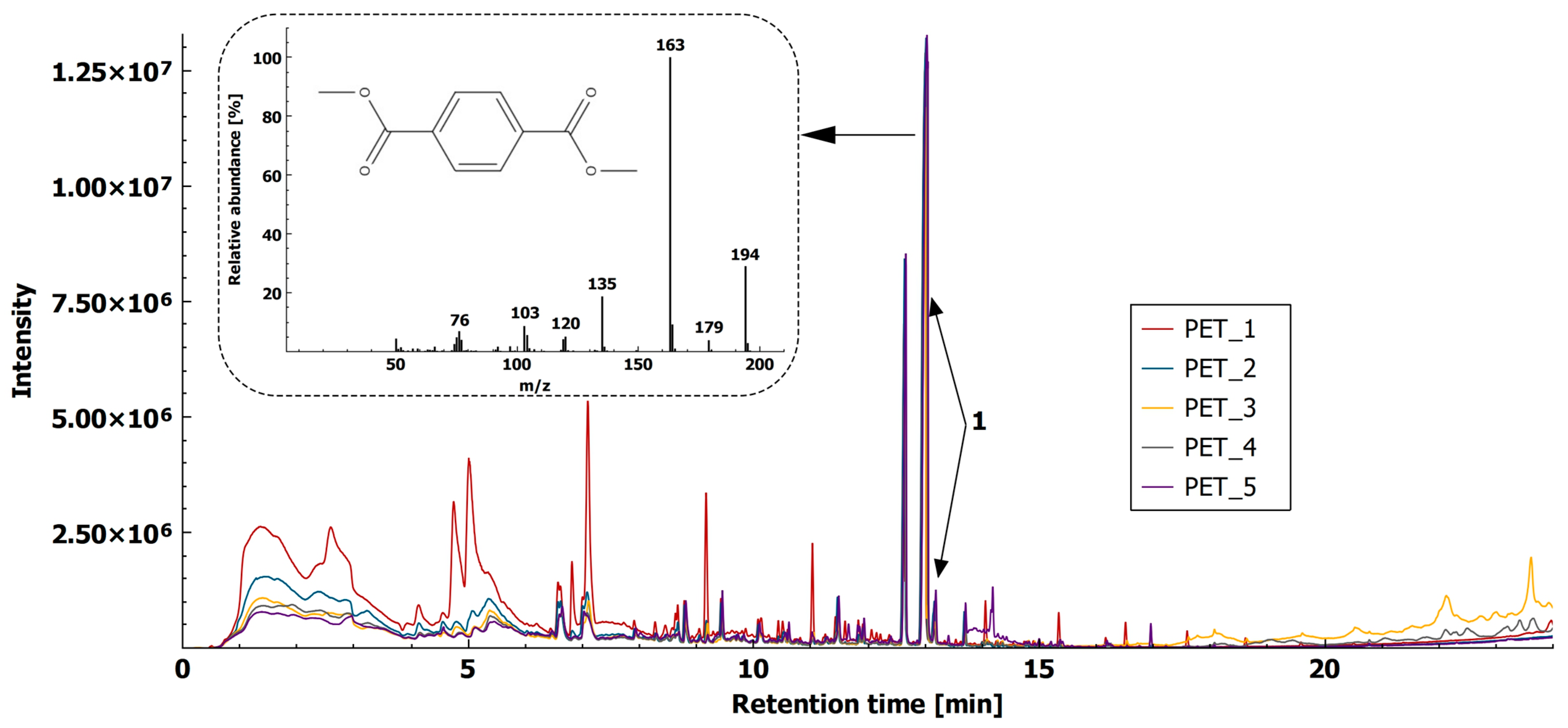
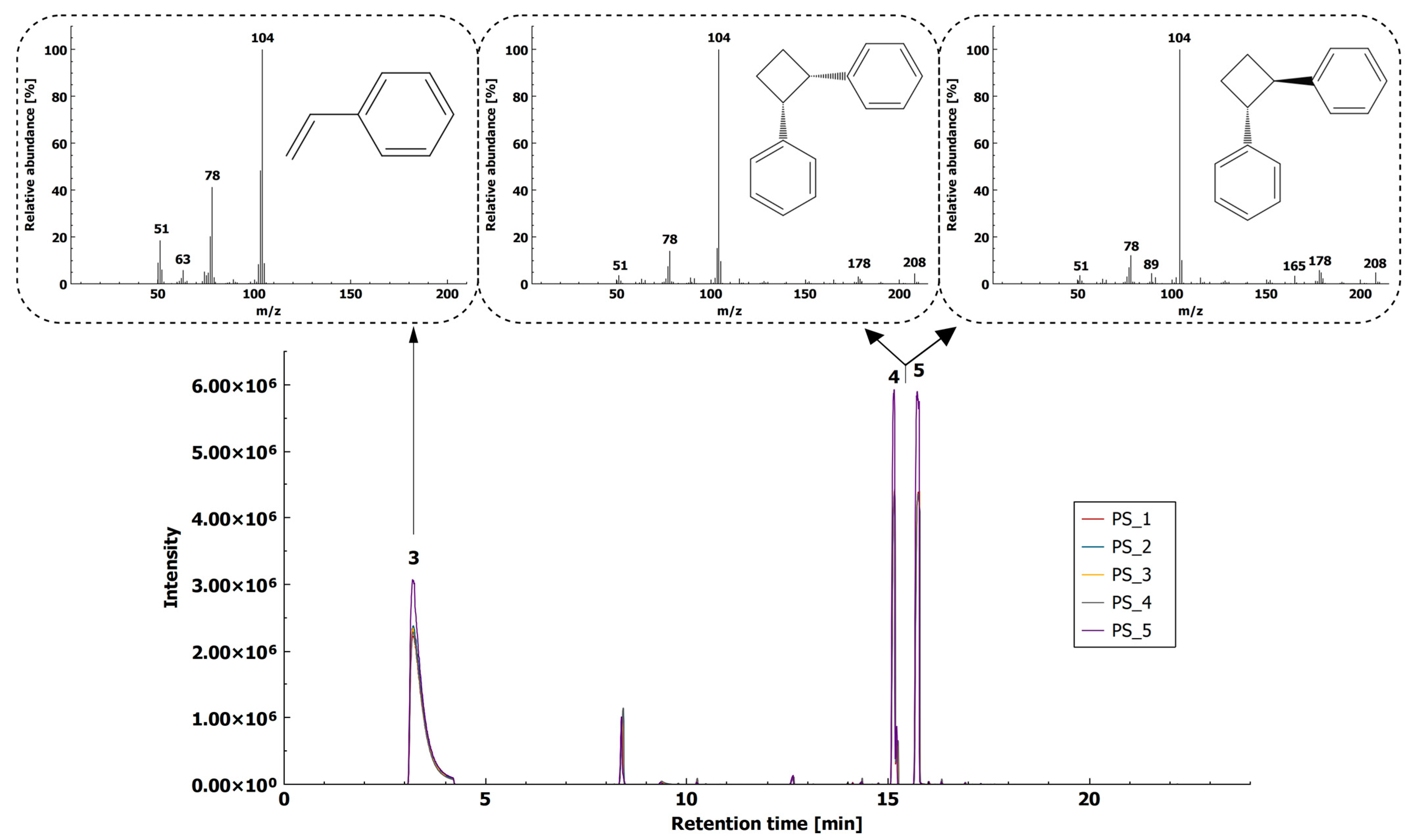
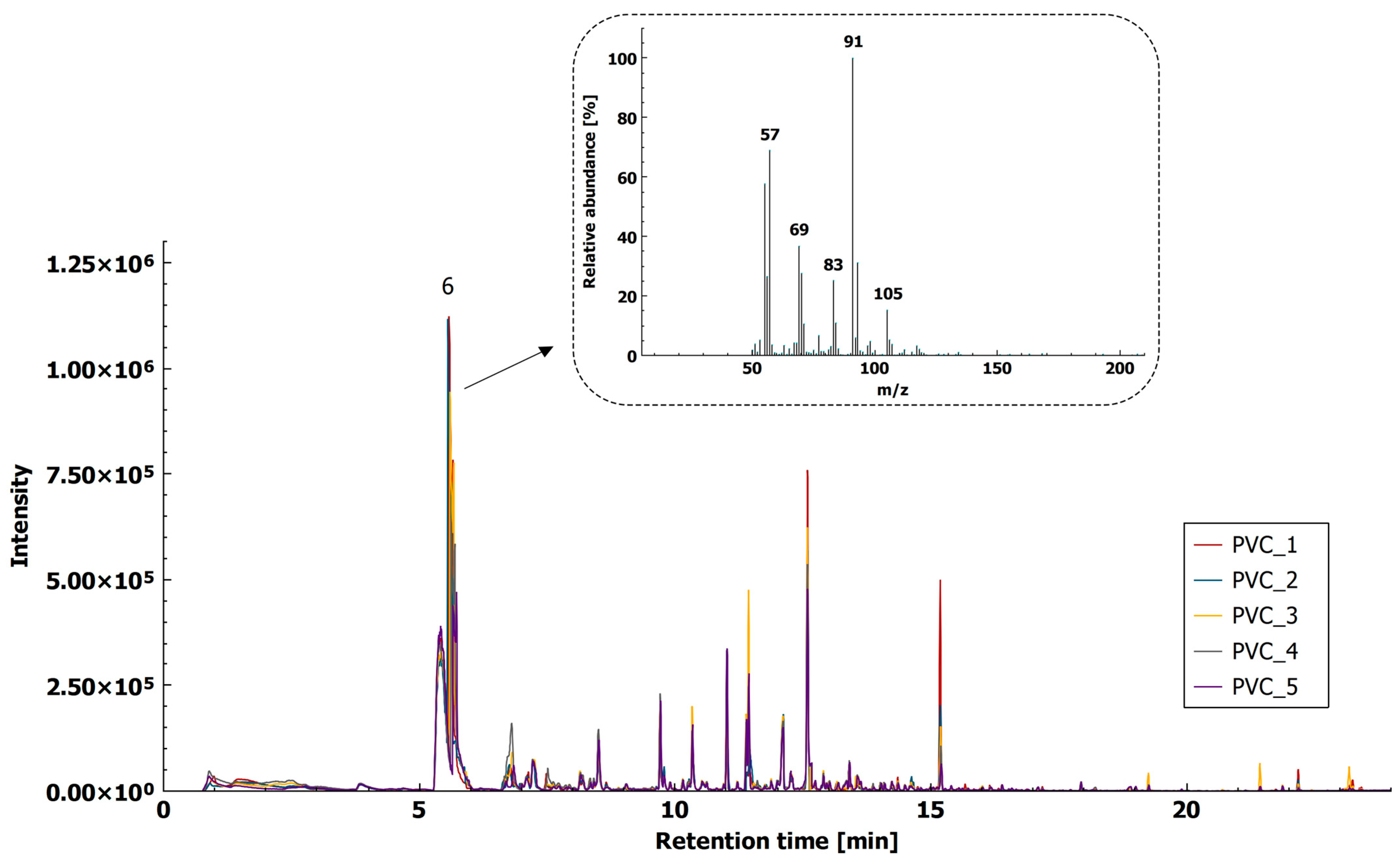
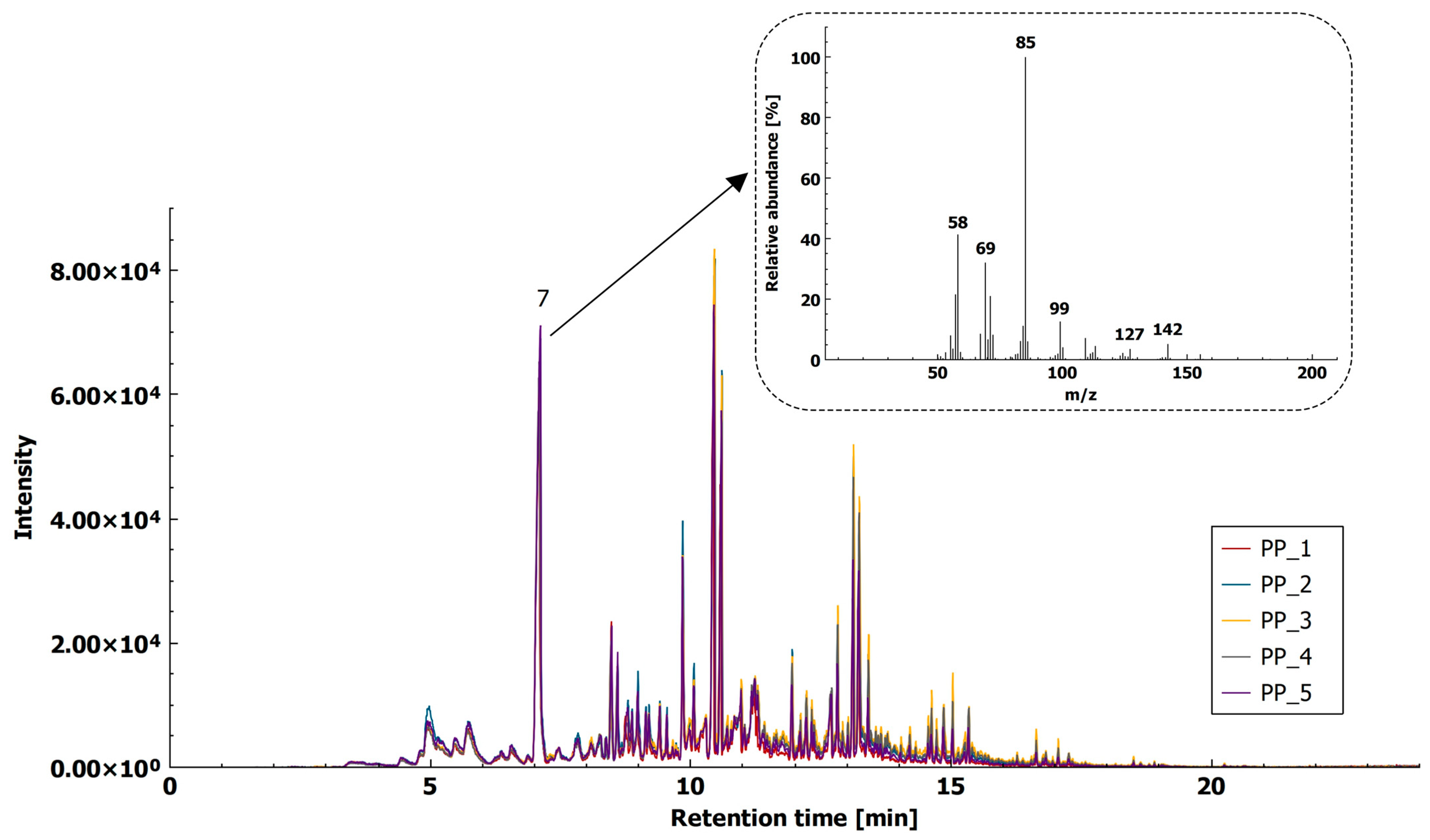
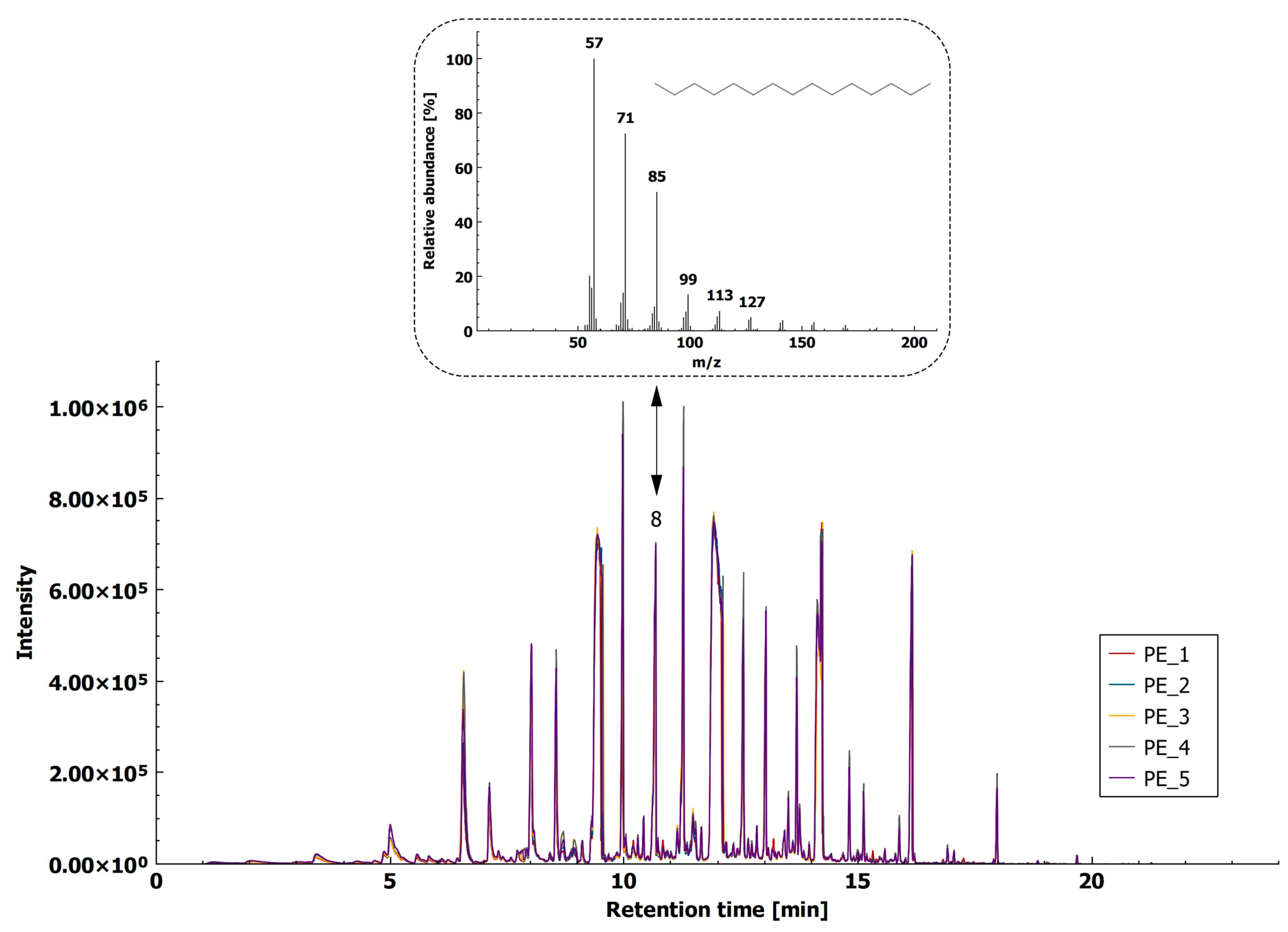
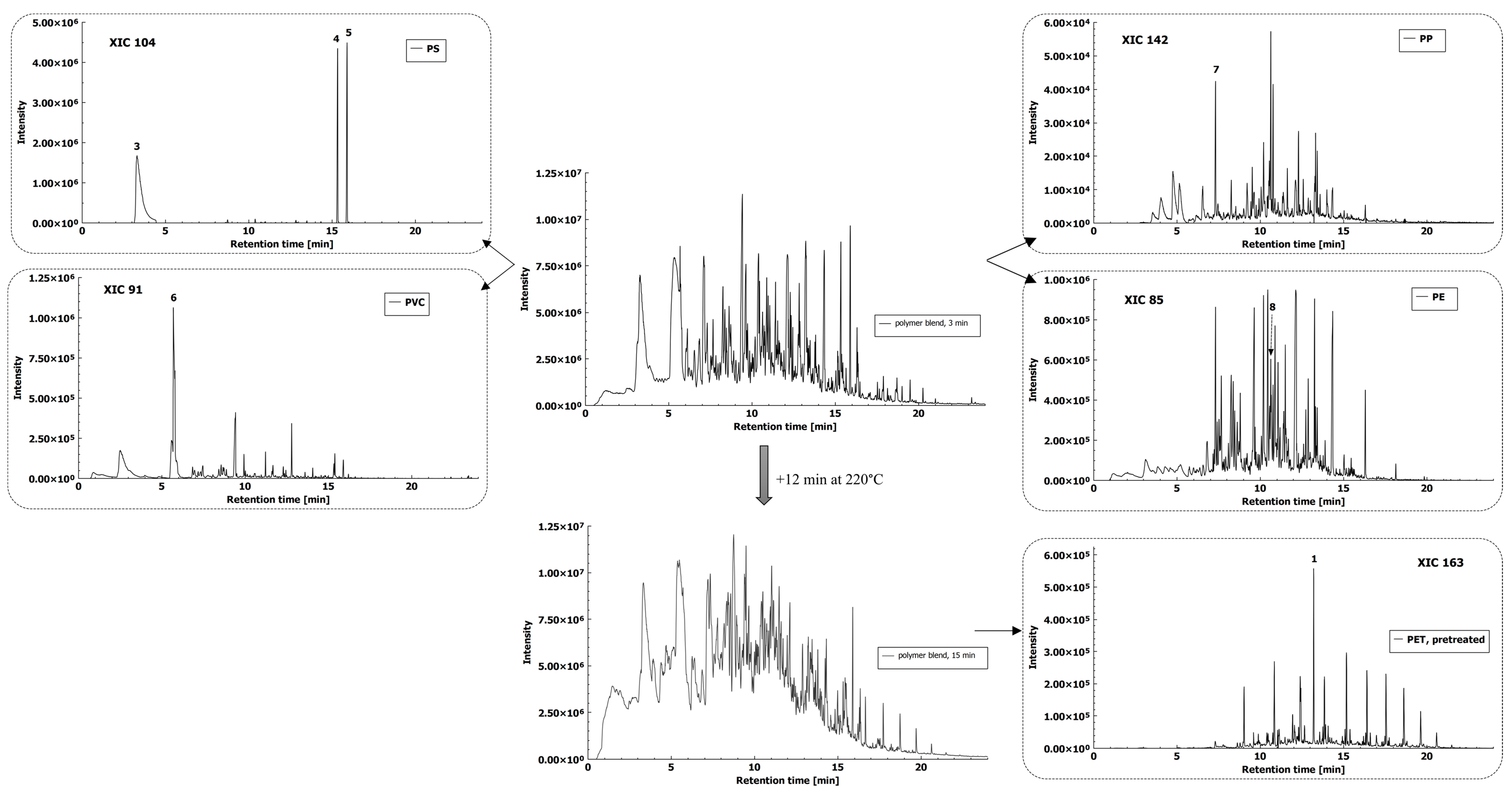
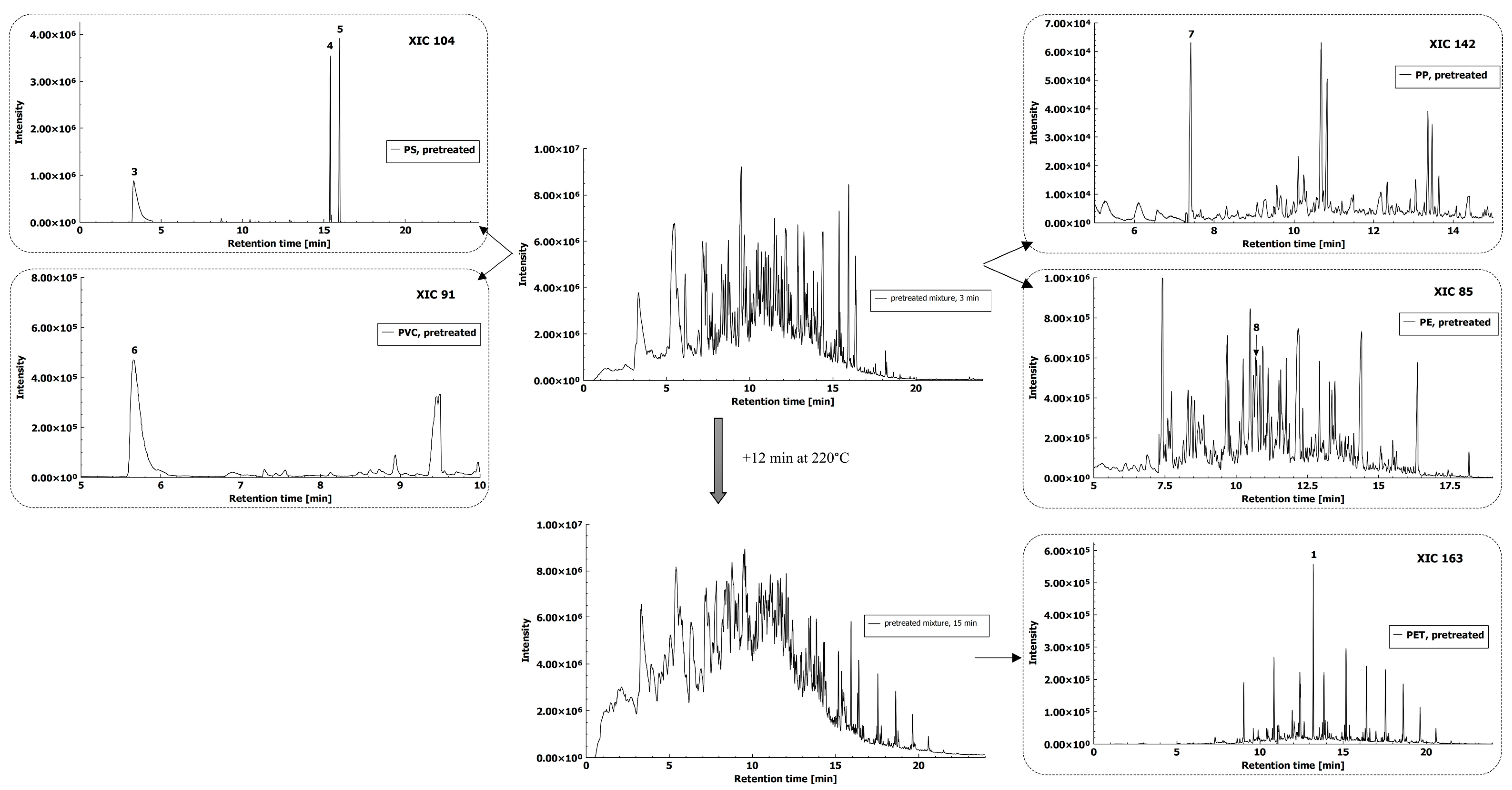
| Polymer Type | Abbreviation | Formula | Density 1 [g/cm3] | Melting Point 1 [°C] | Glass Transition Temperature 1 [°C] |
|---|---|---|---|---|---|
| Polyethylene (low and high density) | LDPE | (C2H4)n | 0.90–0.92 | 141 | −123–−20 |
| HDPE | 0.95–0.96 | ||||
| Polypropylene | PP | (C3H6)n | 0.85–0.88 | 179 | −15–−3 |
| Polyethylene terephthalate | PET | (C10H8O4)n | 1.33–1.48 | 264 | 65–77 |
| Polystyrene | PS | (C8H8)n | 1.04–1.10 | 242–276 | 91–128 |
| Polyvinyl chloride | PVC | (C2H3Cl)n | 1.38–1.40 | 220–305 | 71–107 |
Publisher’s Note: MDPI stays neutral with regard to jurisdictional claims in published maps and institutional affiliations. |
© 2021 by the authors. Licensee MDPI, Basel, Switzerland. This article is an open access article distributed under the terms and conditions of the Creative Commons Attribution (CC BY) license (http://creativecommons.org/licenses/by/4.0/).
Share and Cite
Šunta, U.; Trebše, P.; Kralj, M.B. Simply Applicable Method for Microplastics Determination in Environmental Samples. Molecules 2021, 26, 1840. https://doi.org/10.3390/molecules26071840
Šunta U, Trebše P, Kralj MB. Simply Applicable Method for Microplastics Determination in Environmental Samples. Molecules. 2021; 26(7):1840. https://doi.org/10.3390/molecules26071840
Chicago/Turabian StyleŠunta, Urška, Polonca Trebše, and Mojca Bavcon Kralj. 2021. "Simply Applicable Method for Microplastics Determination in Environmental Samples" Molecules 26, no. 7: 1840. https://doi.org/10.3390/molecules26071840
APA StyleŠunta, U., Trebše, P., & Kralj, M. B. (2021). Simply Applicable Method for Microplastics Determination in Environmental Samples. Molecules, 26(7), 1840. https://doi.org/10.3390/molecules26071840








